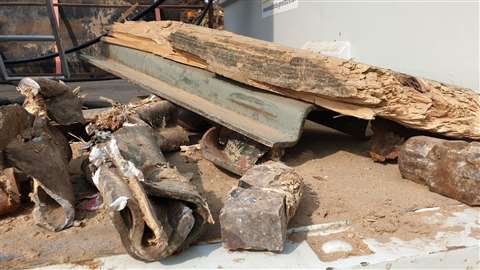Technological innovation means no more wasted opportunities
26 August 2021
Marcus Brew believes that to truly work towards a zero waste future, especially in the demolition sector, collaboration and mindset are just as important as engineering advancements.
As countries vocally pledge to make greater progress when it comes to climate change, there can be no escaping conversation about zero waste strategies and the steps that need to be taken – by everyone – to get us there.
The media is dominated with headlines about carbon reduction, sustainability strategies, upcycling and more, and this is important – the environment has become everyone’s “problem”.
But with this increased interest, not to mention pressure, comes opportunity too. Opportunity that, to date, only those closest to the waste industry itself have perhaps truly acknowledged.
From an engineering perspective, technological advancements are continuing at pace among waste machinery manufacturers. It is now possible to shred a king size mattress in as little as 25 seconds, for example, to liberate the materials that would otherwise remain “locked” inside and achieve a 100 per cent material recovery rate.
That means the salvaging of metal for smelting and remanufacturing, foam breakdown for use as carpet underlay or animal bedding, wood for landscaping mulch or a biomass resource; and textile fibres that can be reused in oil filters or used as flock in energy recovery, to reduce the world’s over reliance on ever depleting fossil fuels. However, this would not have been possible a couple of years ago.
Demolition contractors may not find themselves needing to dispose of many unwanted mattresses. But the point to note here is that machinery innovations are changing the face of what is possible when it comes to transforming even the bulkiest and trickiest of so-called wastes into something new.
Landfill – or worse still, unlawful dumping – is not the only option for these troublesome materials. The handling of these tricky materials could soon become a revenue generating exercise.
Demolition professionals may therefore be keen to note that the same technology, mentioned above, is helping specialist hazardous waste contractors shred contaminated materials such as intermediate bulk containers, rags and oil filters, for re-use, recycling and the production of alternative fuels.
It can process uPVC window frames for ferrous, non-ferrous and clean uPVC recovery. It can aid the recycling of a variety of gypsum board products and liberate high value metals from large redundant electronic appliances right through to mixed skip waste. That is why anything that was previously deemed unshreddable, at least from an economical perspective, should now be re-evaluated for its resource potential.
 Specialist hazardous waste contractors are encouraged to shred contaminated materials
Specialist hazardous waste contractors are encouraged to shred contaminated materials
Post-pandemic effect on environmental industry
The global economic challenges caused by the Covid-19 pandemic have, in some respects, also given the environmental sector this new impetus. In other words, it is not just machinery innovation alone.
Material prices have rocketed, compounded by supply chain difficulties, which means there is more of a fiscal driver to think differently about re-use and recycling.
Secondary materials can often be resold for use instead of virgin equivalents, which represents the potential to generate a new and often growing revenue stream. As a result, an increasing number of demolition firms are closely aligned with waste specialists, and some even have waste handling divisions themselves.
Many of the large manufacturers in the cement industry have even established co-processing facilities, whereby they collect local municipal solid waste (MSW), commercial and industrial (C&I) waste, and construction and demolition (C&D) waste, for recycling, with any residual material being transformed into an alternative fuel that can be used as an energy source when manufacturing cement in their kilns.
Here lies an important point. Where practical, we should strive for material utilisation in line with the waste hierarchy.
While this is a framework conceptualised and adopted by European Union nations, it does to some extent set the precedent in other developed countries too. It recommends that, naturally, the prevention of waste at source is key. However, where waste materials do arise, the next step actions in priority order should be reuse, then recycling and, lastly energy recovery. Landfill should be considered the absolute final resort.
 UNTHA’s ground-breaking machines are well-renowned for WtE expertise
UNTHA’s ground-breaking machines are well-renowned for WtE expertise
Sustainable alternative of Waste-to-Energy (WtE)
So while recovery should not be front and centre of every environmental agenda, Waste-to-Energy (WtE) does represent a relevant option for certain “wastes”.
Contaminated materials that cannot be re-inserted into the manufacturing loop without extensive cleansing, such as PVC processing pipe for example, could make a great fuel source if they have a high calorific value.
Technology may exist to recycle them if rigorously cleaned, but if the process is overly energy intensive or excessively costly, the net environmental gain is minimised if not potentially null and void. There must be a common sense attitude.
Key innovations within the waste machinery space centre on the development of shredding technology which, thanks to a higher torque drive, can operate at slower speeds without any detriment to material throughput rates.
Traditionally, higher speed shredding would have been required which, apart from being dangerous, typically results in regular unexpected breakdowns and costly damage if the machine encounters material that is too difficult if not impossible to shred.
This leads to operational disruption, capacity limitations, excessive maintenance and, overall, a perception that the handling of bulky or heavy-duty wastes, is uneconomical – when it need not be. For example, it is often possible for 38 t waste shredders to pay for themselves in as little as 18 months.
And here comes the financial argument again, which contractors shouldn’t be ashamed of. Because, while a growing number of companies have a genuinely strong environmental conscience, being “green” needs to make commercial sense too. When it does, more people will be financially incentivised to get involved.
Contractors seeking new machines should also look for input material flexibility, as waste streams arising from demolition sites are typically varied. Such versatility means one machine is often equipped to handle very different waste challenges.
 The Waste Wood Assessment Guidance, giving advice on how to handle and process all items of waste wood, was published in July 2021
The Waste Wood Assessment Guidance, giving advice on how to handle and process all items of waste wood, was published in July 2021
Environmental and economic benefits can be maximised
Output flexibility and particle precision matters too. If the shredded material is to be subjected to further downstream processing, a homogenous liberated product is crucial, as uniformity aids the future reuse, recycling or recovery potential. But even the most pioneering of machinery innovations cannot wholly solve the C&D waste challenges being experienced on a global basis.
Sadly, legislation is often required to drive true innovation, which goes some way to explaining the introduction of new Waste Wood Classification Guidance. While currently specific to the UK market only, it will not be long before other countries follow suit when it comes to this waste stream.
A mindset shift would also undoubtedly help. The very term “waste” is unhelpful of course. It conjures up somewhat dirty images of rubbish that has reached the end of its useful life. Some contractors still see waste as a headache that they are keen to pass on. But the examples outlined highlight that even the most complex wastes are not actually a headache any longer.
They would be even less of a headache if stakeholders at earlier stages in the value chain thought about what will happen to buildings, structures, plant and equipment, when it reaches the end of its operational lifecycle.
Because, just as product innovation in the domestic appliance and car manufacturing sector has evidenced, if reuse is factored into the design of something before it even exists, it is far easier to cleanly and efficiently break the item down into its component parts when it is no longer being used. The environmental and economic benefits can therefore be maximised as a result.
In many respects, demolition and waste set a shining example for others. Many demolition sites boast 90% to 95% material recycling rates, particularly in high profile projects likely to impose greater scrutiny during the contractor’s tender and selection process. And clever onsite segregation of materials usually lies at the heart of successful material handling and onward treatment.
But while steel and aggregates from heavy buildings can now be reused and recycled with ease, and “waste” such as redundant cables is now a huge environmental success story, the resource value in 5% to 10% of site materials remains untapped, with far more potential than people think.

He is managing director of UNTHA UK, based in north east England. Headquartered in Austria, UNTHA is a globally renowned shredding manufacturer, with more than 10,000 machines in operation globally.
Having celebrated its 50th anniversary last year, the engineering firm has helped transform even the most troublesome and complex “wastes”, including materials arising from construction and demolition projects, into valuable resources that can be saved from landfill.
Click here to visit the UNTHA UK website
CONNECT WITH THE TEAM








